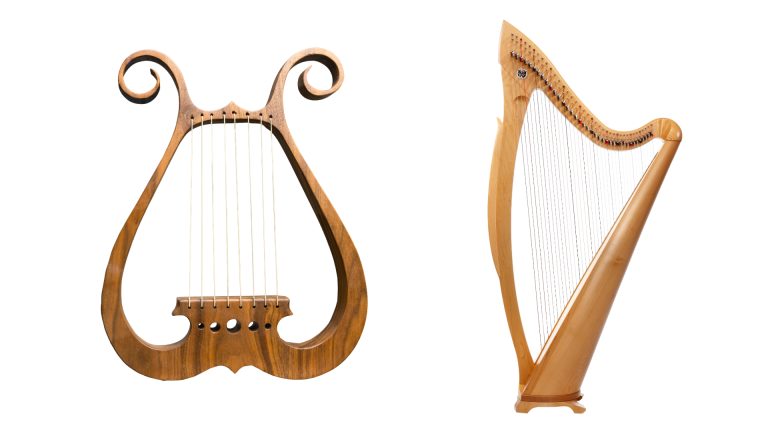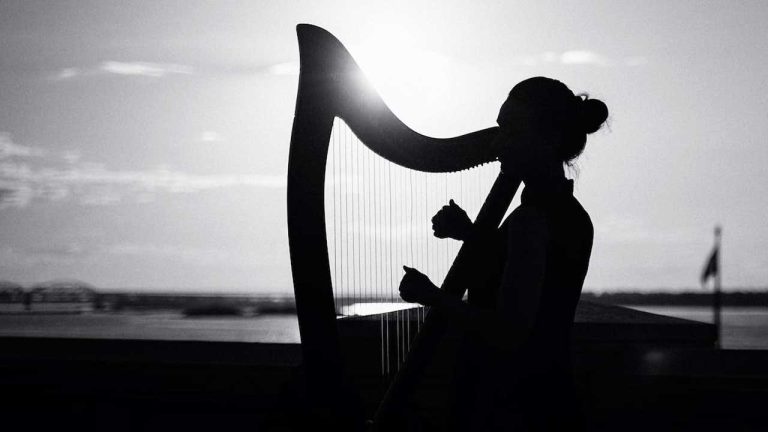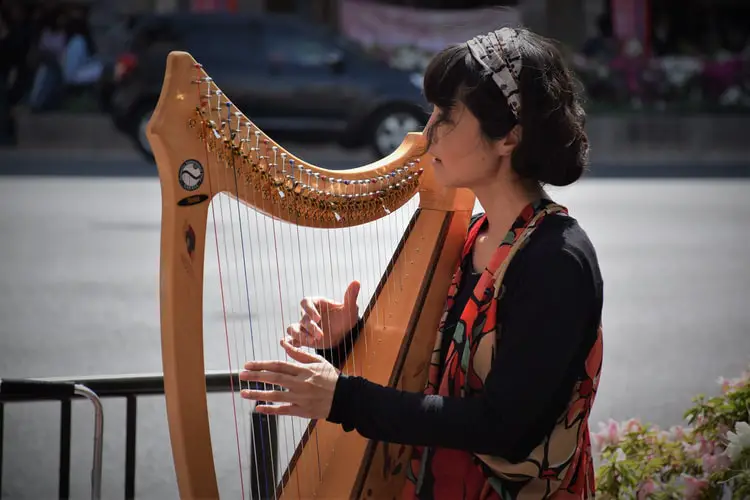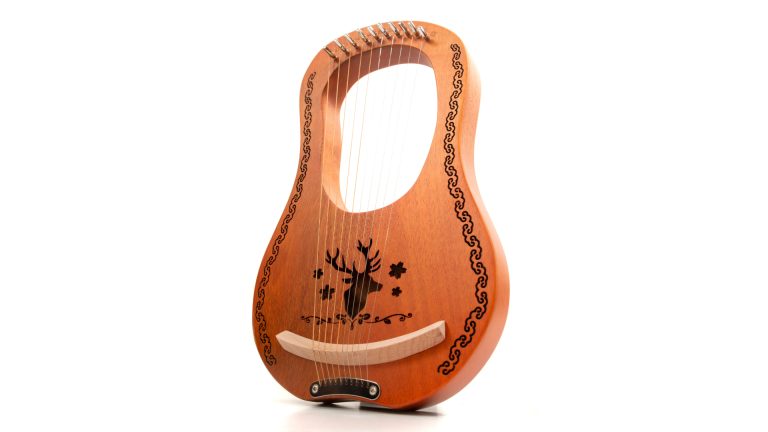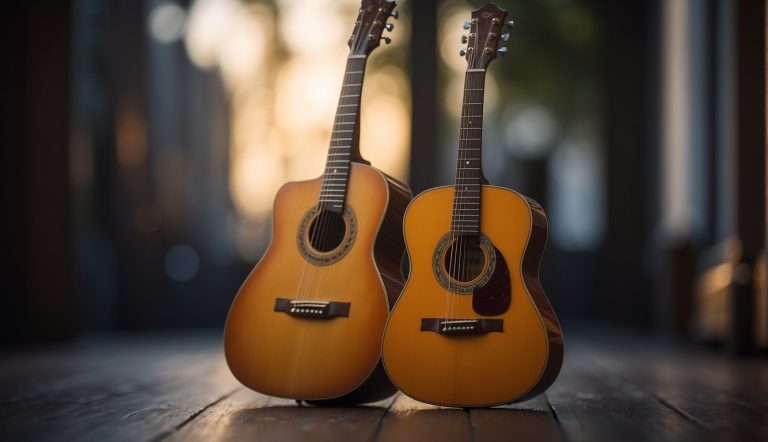Does Playing the Harp Hurt Your Fingers? Understanding the Reality of String Instruments
Folkstrings.com is reader-supported. When you buy through links on our site, we may earn a small commission.
Playing the harp can be a deeply rewarding musical experience, revered for its soothing sounds. It is also considered one of the most beautiful instruments both visually and aurally.
However, as with any string instrument, learning to play the harp involves a physical adjustment period for the fingers.
The friction of the strings against the skin and the pressure needed to create sound can initially lead to discomfort and calluses.
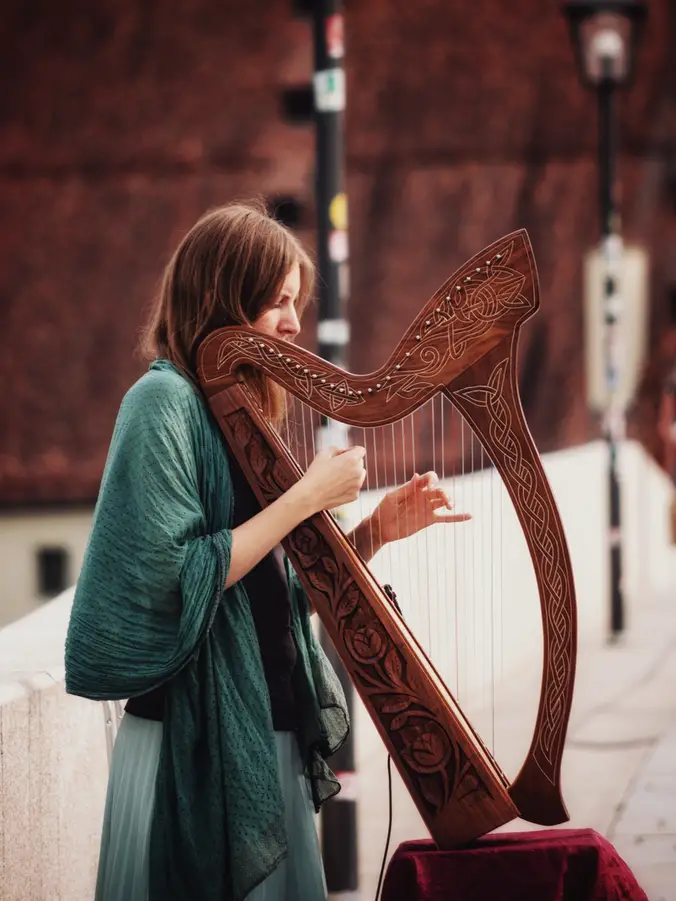
With time and proper technique, most harpists find that their fingers become accustomed to the demands of the instrument. Using correct hand position and gentle plucking movements can significantly reduce the risk of pain and injury. It’s important to listen to your body and take breaks when necessary, ensuring you do not strain your fingers or hands.
Moreover, incorporating exercises to strengthen finger agility and flexibility can help in easing the learning process. To further prevent discomfort, varying your practice routine and paying attention to ergonomic principles is crucial.
Key Points
- Playing the harp requires finger strength and may cause initial discomfort.
- Proper technique and hand position are essential for reducing the risk of finger pain.
- Regular breaks and exercises are key to managing and preventing finger discomfort from harp playing.
Understanding the Harp and Its Impact on Fingers

When I consider how playing the harp affects my fingers, I think about the balance between string tension and fingertip contact. This balance requires finesse and can lead to both physical challenges and the development of skills.
Harp Strings and Finger Tension
Material of Harp Strings: My harp’s strings are made from various materials—nylon, gut, and wire—which affect the tension my fingers feel. Nylon strings are softer and typically create less tension on my fingertips. Gut strings have a higher tension, requiring a firmer plucking motion. The wire strings, often found in the lower register, demand the most strength due to their rigidity and tension.
Fingertip Pressure: Playing the harp involves pressing the strings with the pads of my fingers, which can create friction. Over time, I’ve noticed that this pressure develops calluses on my fingertips, offering some protection against the strings’ tension.
- Nylon: Softer feel, low tension
- Gut: Higher tension, firm pluck required
- Wire: Highest tension, strength needed
Common Physical Challenges for Harpists
Building Calluses: As a harpist, I’ve had to build up calluses on my fingers to help withstand the constant contact with the strings. Calluses reduce the pain and protect my fingertips from the pressure of plucking. When I started playing, the absence of calluses made playing more challenging.
Navigating Glissandi: Glissandi are a hallmark of harp playing, where I gracefully slide my fingers across the strings to create a sweeping sound. This requires a delicate touch to avoid too much friction, which could hurt my fingers. Maintaining the right fingernail length is crucial; too long, and they might catch on the strings, too short, and the fingertips endure excess pressure.
- Callus development: Protects from string pressure
- Glissandi technique: Balance between fingertip and nail contact to minimize friction
Effective Playing Techniques
When I approach the harp, I ensure that my technique promotes both beautiful music and my personal well-being. Here are some of the practices I’ve adopted to play effectively without harming my fingers.
Proper Hand Positioning and Movements
I always start by checking my hand position, as this is critical to avoid strain. My fingers are curved gently, thumb above the level of the index finger, allowing me to pluck the strings with control and a relaxed touch. I avoid overextending my fingers and thumb, which keeps them from getting sore after playing.
Here’s how I place my hands on the harp:
- Thumb: High and bent, not collapsing at the joint.
- Index finger: Slightly lower than the thumb, also bent.
- Middle and ring fingers: Align with each other, almost creating a staircase effect in descending order.
- Little finger: Though not used to play, I keep it relaxed and not stiffened or curled excessively.
Through regular practice, I aim for fluid hand movements, ensuring each gesture is deliberate and precise. I note that the wrists should be neither too high nor too low, and movement should stem from the finger joints, not the palms or wrists.
Preventative Practices for Beginners
As a beginner, I took special care not to rush into complex pieces that would strain my hands. Instead, I focused on building my endurance gently through:
- Regular warm-up exercises: Before delving into longer playing sessions, I always warm up my hands with simple exercises to get my blood flowing and muscles loose.
- Incremental practice: I increase practice duration slowly to build up my finger strength without overexertion.
- Fingering techniques: I am meticulous about using the correct fingers for the strings, ensuring I minimize awkward hand positions that can lead to discomfort or injury.
In addition, I rest my hands frequently during long practice sessions. The adherence to these practices has been pivotal in keeping my fingers nimble and pain-free while I continue to enjoy making music with my harp.
Managing and Preventing Pain
In my experience playing the harp, paying close attention to my techniques and symptoms has helped me manage and avoid pain. Below I’ll outline specific ways to recognize symptoms and long-term strategies that have been effective for me and other harpists.
Recognizing and Treating Symptoms
At the first sign of pain or discomfort in my fingers while playing the harp, I take it seriously. Blisters and calluses can be common, but they should not be painful. It’s important to remember that these can lead to more significant issues if not treated properly.
Inflammation is another sign that I’ve learned not to ignore. Whenever I feel unusual pain or see swelling, I give my fingers time to heal. If over-the-counter treatments (such as bag balm or creams containing lanolin) don’t bring relief, I consult a doctor or a harp teacher for advice.
Practicing proper hand position and taking regular breaks has helped me minimize the risk of repetitive strain injuries like osteoarthritis and carpal tunnel syndrome. If I experience persistent pain that doesn’t improve with rest and self-care, seeking medical advice is always my next step.
Long-Term Health Considerations for Harpists
Maintaining my long-term health as a harpist involves a proactive approach. I incorporate finger-stretching exercises into my daily routine to keep my hands flexible and strong, and I’m careful about my posture while playing. I’ve also found it helpful to:
- Warm up adequately before sessions
- Adjust my harp’s position for ergonomics
- Use adjustable benches to ensure proper seating
Protecting my fingers also means being attentive to the development of calluses, which, while normal, require proper maintenance to prevent cracking and discomfort. When calluses become too thick, I gently file them down and moisturize regularly.
Lastly, I’ve learned that a support network is invaluable. Regular appointments with a physical therapist and conversations with fellow harpists about managing hand health have broadened my perspective and equipped me with various strategies to prevent injuries. When in doubt, I don’t hesitate to seek professional guidance to nurture my passion for playing my harp pain-free.
Caring for Your Hands Beyond the Harp
Taking care of my hands is essential, especially when I step away from the harp. Maintaining their health ensures that I can play blister-free and keep my joints supple for both rehearsals and performances.
Daily Hand Care Regimen
I have developed a daily routine to keep my hands in top condition. Here’s what I do each day:
- Morning and Night Moisturizing: I use a nourishing hand cream twice daily to keep my skin hydrated and prevent dryness that could lead to blisters.
- Stretching: Before I start my day and after playing, I gently stretch my fingers, palms, and wrists to maintain flexibility.
- Strength Exercises: I incorporate finger strengthening exercises to build resilience in my joints and muscles.
Lifestyle Adjustments for Optimal Hand Health
There are specific lifestyle changes I’ve made that benefit my hand health:
- Balanced Diet: I ensure my diet is rich in calcium and Vitamin D which are vital for bone health, including my hands.
- Regular Breaks: During rehearsals, I take breaks to rest my hands, preventing overuse of my left hand, which is particularly crucial in harp playing.
- Mental Well-being: I also focus on my mind, because tension and stress can translate to tightness in my body, affecting my hand health. Mindfulness practices help me stay relaxed.
- Protective Measures: I keep my hands safe from harsh chemicals and extreme temperatures that could harm my skin or joints.
Frequently Asked Questions
In this section, I’ll address some common questions you might have about playing the harp and how it relates to finger pain or discomfort.
How can I minimize finger pain when learning to play the harp?
To minimize finger pain, I always recommend beginners start with shorter practice sessions and gradually increase duration. It’s also crucial to maintain proper hand position to reduce strain.
Are calluses common for harpists, and do they affect sensitivity when playing?
Yes, calluses are fairly common among harpists. They can reduce fingertip sensitivity slightly, but they also protect the fingers from pain during lengthy playing sessions.
What is the reason for harpists not using their pinkies to play?
The pinky is typically not used because it’s shorter and weaker than the other fingers. This makes it less effective for plucking the strings and achieving the desired sound quality on a harp.
How many fingers are typically used when playing the harp?
Typically, I use my thumb and the first three fingers on each hand when playing the harp. This gives me a total of eight fingers to work with.
Is it necessary to have long fingernails to play the harp effectively?
No, it’s not necessary to have long fingernails. In fact, overly long nails can interfere with technique. I keep my nails short to medium length to pluck the strings effectively.
Are there any tools or accessories to protect fingers while playing the harp?
Some harpists use finger guards and tapes to protect their fingers. These can be helpful, especially when you’re starting out and haven’t developed calluses yet.
Author Profile
-
Daniel Johnstone is an English writer with a love for stringed instruments from around the world.
He shares his love for these instruments through his writing for folkstrings.com, a website dedicated to all things related to folk string music.
Daniel's passion for music started at a young age, and he has since become an accomplished musician, playing guitar, cavaco, and recently, the harp.
His dedication to learning and sharing his knowledge of stringed instruments is evident in his insightful and engaging blog posts. Whether you're a seasoned musician or a beginner, Daniel's writing is sure to inspire and entertain you.
When he's not playing music or writing, you can find Daniel exploring new instruments and seeking out new sounds to share with his readers.
Latest entries
 AutoharpApril 4, 2024What Is the Autoharp Made Of: Exploring Its Materials and Craftsmanship
AutoharpApril 4, 2024What Is the Autoharp Made Of: Exploring Its Materials and Craftsmanship AutoharpApril 4, 2024Is Autoharp Easy to Play? Unveiling the Truth for Beginners
AutoharpApril 4, 2024Is Autoharp Easy to Play? Unveiling the Truth for Beginners AutoharpApril 4, 2024What Is an Autoharp Worth? Your Guide to Pricing and Value
AutoharpApril 4, 2024What Is an Autoharp Worth? Your Guide to Pricing and Value AutoharpApril 4, 2024Are Autoharp and Zither the Same Thing? Unraveling String Instrument Myths
AutoharpApril 4, 2024Are Autoharp and Zither the Same Thing? Unraveling String Instrument Myths
Affiliates:
This post may contain affiliate links that at no additional cost to you, the site may earn a small commission. We only recommend products we would use ourselves and all opinions expressed on this site are our own.
Accuracy Advice:
While we strive to provide up-to-date and accurate information, the content in this article may not reflect the most current research or medical guidelines. We encourage readers to do further research and consult with professionals for more personalized advice.
Our Recommendations:
The products and services mentioned in any of our articles are recommended based on our independent research and personal experience. We are not sponsored by any company. We aim to suggest products and services we believe are of high quality and could be beneficial to our readers.

